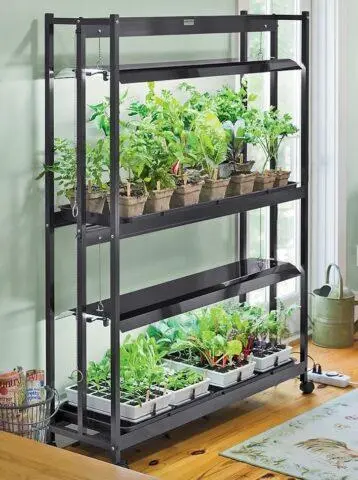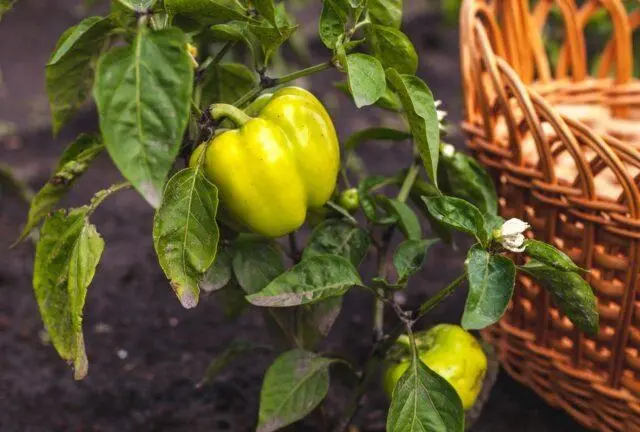Contents
If the pepper leaves turn yellow, this is a developmental disorder, the causes of which are most often associated with improper care. Yellowing is observed at different stages – from seedling shoots to adult bushes in a greenhouse or in open ground. For treatment, it is necessary to establish normal watering, give fertilizers in time and, just in case, carry out treatment from insects and other pests.
Why do pepper leaves turn yellow?
If the leaves of the bell pepper turn yellow, the reason is probably due to improper care. Very often this happens due to unbalanced fertilizers, errors in watering. The soil may also be incorrectly composed or an invasion of pests is observed.
Unsuitable soil composition
Peppers are very sensitive to the composition of the soil – on depleted soils, its leaves turn yellow and fall off, and the yield inevitably decreases. There are several requirements for the land at once:
- high level of fertility;
- varied composition;
- not too thick consistency;
- slightly acidic or neutral reaction (pH 6,0 to 7,0).
For growing seedlings, universal soil is suitable, which can be purchased at the store. If you make the mixture yourself, it is recommended to take garden soil and mix it with humus, black peat and sand (2: 1: 1: 1). When preparing the soil in a greenhouse or on a garden bed, it is dug up in advance and compost or humus is added in the amount of 5 kg per 1 m².
Watering errors
Yellow spots on pepper leaves can also be associated with a violation of watering. Moreover, not only a lack, but also an excess of water is bad. In both cases, the foliage turns yellow. The basic rules for watering are:
- Use only settled water at room temperature.
- Water seedlings three times a week, and adult bushes twice.
- Pay attention to the surface layer of the soil – it should remain only slightly moist.
In this case, it is possible to achieve optimal soil moisture. The leaves do not turn yellow and remain healthy.

To prevent the leaves from turning yellow, you need to avoid excessive and weak watering.
Fertilizer shortage
Lack of fertilizer has a bad effect on any plants, especially capricious crops such as peppers, tomatoes and eggplants are especially sensitive to it. Deficiency of one or another nutrient (for example, phosphorus, potassium) is called chlorosis. Moreover, the symptoms of this disorder manifest themselves in different ways:
- The lower leaves of the pepper turn yellow, and the tips dry out, while the trunk becomes harder, and the fruits curl – potassium deficiency.
- If the veins turn yellow first, and then the entire leaf, starting from the middle part, this indicates a lack of nitrogen. At the same time, the tops quickly die and fall off.
- If yellow streaks appear on the pepper leaves, and then the entire plate becomes pale, it means that there is a lack of sulfur.
- If the leaf plates turn yellow at the edges, and then over the entire surface, this indicates a lack of iron and magnesium. Moreover, the color will be saturated – often orange and even red.
- If the cotyledon leaves of the pepper turn yellow (i.e., the first pair that appeared after the emergence of seedlings), this clearly indicates a lack of nitrogen.
The condition of the leaves and other parts of the plant is badly affected not only by the deficiency, but also by the excess of nutrients. Therefore, fertilizers must be applied in accordance with the instructions. If the soil is already fertile enough, the standard amount is reduced by 1,5 times.
It is used not in its pure form, but as part of complex fertilizers, Kemira Lux or Baikal. If you just give urea or saltpeter, the seedlings will begin to stretch, which will have a bad effect on the further development of the bushes.
Bad light
Peppers are also sensitive to light. It is especially important to provide illumination in the first month of growing seedlings. For this, special phytolamps or LEDs are installed. They should work in such a way that the daylight hours are at least 12 hours, but not more than 14. Then the duration of illumination is gradually reduced, since the seedlings can be stretched.

Before starting cultivation, it is necessary to provide a lighting system
When kept in a greenhouse on hot days, they create shading. You can do this in the open field. For example, by placing a white awning or other shelter. Planting plants in shady places is not worth it, since the lack of sunlight leads to the fact that the leaves begin to turn yellow. Under such conditions, plants often lag behind in development.
Temperature changes
If the leaves of sweet peppers turn yellow in the open field, and at the same time the care is quite normal, the reason may be related to adverse weather. If night temperatures drop below +10 degrees, and during the day, on the contrary, heat rises above +28 ° C, this can also lead to light spots on the leaf plates. There is only one solution – to grow a crop in greenhouses or greenhouses. This is especially important for northern regions with short and cool summers.
Root damage
Pepper does not tolerate picking quite well. The root system is still weak, and even if you act carefully, it can be easily damaged. As a result, the seedling weakens, which is badly reflected in the condition of the foliage. Although if the damage is small, the plant will recover over time – in this case, only the cotyledon leaves can suffer.
Pests and diseases
Finally, the foliage may turn yellow due to diseases, as well as the action of pests. Most often, landings are attacked by spider mites and aphids. Ticks are microscopic in size, but it is quite easy to detect them by a whitish coating on the underside of the leaf plate.
Aphids can be seen visually, especially since the pest colonies are very large. They feed on plant juices, as a result of which the leaf not only turns yellow, but also curls and then dies.
To prevent the leaf plates of pepper from turning yellow, you need to treat the plantings with insecticides:
- “Biotlin”;
- “Fitoverm”;
- Karbofos
- “Inta-Vir”;
- “Actara”.
If there are not very many insects, and the leaves have just begun to turn yellow, you can use folk remedies, for example, an infusion of garlic, onion peel, mustard powder. The same recipes can be used for prevention.

Pepper leaves may turn yellow due to pests or diseases.
Also, the appearance of yellow spots may be associated with fungal infections – downy mildew and fusarium. In the first case, separate light dots appear on the leaf plates, which then merge into large spots. The surface becomes white, then turns yellow. Then it is dyed brown.
Due to Fusarium, the tips of the lower foliage turn yellow. The disease gradually spreads to the overlying parts. Treatment should begin as soon as possible. Otherwise, the disease will spread to neighboring plantings.
To prevent the leaves from turning yellow, effective fungicides are used for processing:
- Fundazol;
- “Profit”;
- “Tatu”;
- “Score”;
- “Abiga-Peak” and others.
If the crop is cultivated in open ground, the processing is done in dry and calm weather.
Why do pepper leaves turn yellow in a greenhouse
When grown in a greenhouse, pepper leaves may turn yellow for the following reasons:
- too high temperature;
- temperature fluctuations;
- depleted soil;
- excess or lack of watering.
For prevention, the greenhouse must be constantly ventilated, as well as monitor the humidity.
Causes of yellow leaves in peppers in the open field
In the open field, pepper leaves often begin to turn yellow due to the weather factor. The plant is very thermophilic, and even short-term night drops to +10 degrees can lead to negative consequences. Therefore, seedlings should be transplanted into beds no earlier than the beginning of May, and in Siberia and the Urals – closer to June.
Also, pepper leaves may turn yellow for other reasons described above. This phenomenon can be associated with inappropriate soil composition, shady places, lack or excess of fertilizers, improper watering, and others.
What to do if the lower or upper leaves of the pepper turn yellow
Sometimes summer residents are faced with such a phenomenon: only the upper or lower leaves turn yellow in pepper, while the rest look quite healthy and grow normally.
If yellowing has spread only to the lower foliage, there are three most likely causes:
- Irrigation with cold water. It must first be defended overnight at room temperature (or left under the bright sun). Pour only under the root, avoiding contact with the green parts.
- Incorrect picking – if the roots of the plant are damaged, the foliage may also turn yellow.
- A similar phenomenon is also possible due to improper transplantation, when the root system is damaged due to careless actions. Therefore, the day before, the plants need to be watered and left for 1-2 days to form a fairly dense earthen ball.
Yellowing of the upper foliage is associated with abundant light, lack of fertilizer or watering. There may be other reasons described above, for example, pest infestation.

Leaves may turn yellow en masse or individually.
preventive measures
It is possible and necessary to avoid yellowing of peppers. To do this, you must follow the basic rules of care:
- Since the seedlings do not tolerate transplanting well, it is better to grow it immediately in separate containers. To do this, use peat pots, tablets or plastic glasses. Three seeds are planted in each. If they all sprout, pinch the weak seedlings, leaving one strong seedling each.
- Be sure to feed the seedlings at least once with a complex fertilizer.
- A few days after transplanting the pepper into the ground, it is necessary to treat it with a fungicide. It is enough to do this once or maximum twice a season. Moreover, during fruiting for spraying, it is better to use biological preparations or folk remedies.
- Follow normal watering, giving water 1-2 times a week.
- Fertilize up to 4-5 times per season with an interval of two weeks.
- Ventilate the greenhouse regularly.
Conclusion
When the leaves of the pepper turn yellow, this indicates a violation of the rules of care. You need to check if the soil is not too dry or moist. It is also recommended to fertilize and treat from pests. If the care is normal, the reason is probably due to excessive or insufficient lighting. It can also be adjusted by yourself.









